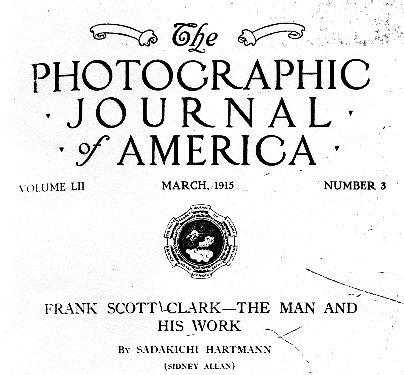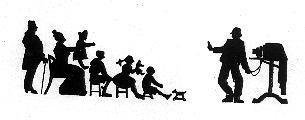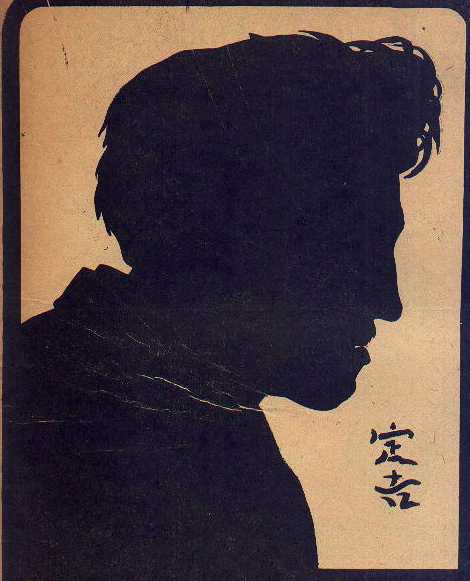
AN
ARTICLE BY SADAKICHI HARTMAN (Sidney Allan)
by
Thomas Yanul

One
winter evening, following a dismal day of yellow fog and blizzardy winds,
when I sat disconsolate and weary, not knowing what to do with myself, in
my room in a Chicago hotel, Dundas Todd paid me a visit. At that time he
had not yet gone into bee culture but was still writing his able educational
articles for THE
BEACON.[the Photo Beacon]
[
ed.note-Photographer/publisher Todd left Chicago about 1906 and moved
permanently to British Columbia, Canada, where he became
a bee keeper with the
government-he did not publish or participate in photographic
circles again]
So
we talked on general photographic matters, until he made the apparently very
casual remark that some of the top notchers of the profession were holding
an unceremonious confab at the Lexington, [hotel] criticising each other's
prints, discussing the situation, and having a good time all around. Well,
I suggested, we will join them. "I do not exactly know," murmered Todd,
whether"--then he got up and disappeared for while. There was a decided mystery
about the affair. When he came back he said: "Yes, they would like to meet
you." So we started and were ushered into a hotel parlor with prints
on a round table in the middle and plenty of liquid food on the mantelpiece
and dressers, while a dozen men or more were distributed in groups about
the room. There were present at this memorable occasion big jolly
J.C.[Strauss] and Godlove, his loyal adjutant; Kraffl from Knoxville
[most likely Knaffl of Knaffl Bros]; genial Rinehart from Omaha; sturdy Stein
of Milwaukee; of course, also, the Commodore with one of his sons [M.J. Steffens
& son Leo] and if I remember rightly, Edmonson from Cleveland [probably
G.W. Edmondson], and Frank Scott Clark from Detroit. Surely a striking
bunch of personalities that one could not easily forget, and among them Frank
Scott Clark held peculiarly his own. There was an esthetic flavor about his
face and figure, and a mild magnetism that must have done him many a good
turn under the skylight. He seemed to be the artist of the crowd. This
was 1902, or thereabouts.
Clark
was already well known in the profession. He had strated as early as 1880,
when he worked for W.T. Richardson, an English practitioner in New York City.
Then he drifted to J.M. Brainard's studio in Rome, N.Y.. In 1892 he came
to Detroit, and the result was the opening of the well-known studio of Huntington
& Clark. In 1902 the parnership was dissolved, and Clark started
for himself in that quant little frame building on Woodward avenue, so unlike
other establishhments, impressing one by its home-like atmosphere, where
photography is practised not so much a business as an art. Clark went
his own way, and easily took his place in the front rank, in which he had
so long deserved to be. For twenty-two years he has remained loyal
to Detroit, and no portrait photographer has depicted Detroit society so
completely or in a manner so varied. None has represented more truly or more
delicately the characteristic traits of it inhabitants, the expression of
their faces, their gestures, and the love for contrast that strikes the visitor
as being one of the characteristics of woman's dress in the State of Michigan.
All his pictures are marked with the characteristic imprint of an artist's
talent --full of grace and poetry and sweetness. From the countless
portraits of men, women and children, all marked by an external resemblance,
and realizing in a characteristic manner the essentials of the person depicted,
the writer of these lines has selected a dozen or more for illustraitive
purposes. It did not take him long, as nearly all prints showed a certain
standard of perfection. The average quality of Clark's work is truly
astonishing in its evenness or workmanship, its artistic taste, and beauty
of quiet, well-harmonized tonalities. His little studio building is
admirably adapted to its purpose. There are several rooms on the ground floor,
all well proportioned and pleasantly lighted and arranged so as to set off
to good advantage the simple, old-fashioned furniture and the few pictures
exhibited in them. There are but few of Clark's prints in evidence,
even the large portfolios lie in an inconspicuous corner in the studio.
Clark does not make a habit of showing his former work to new
customers.
If
they insist on seeing examples he is willing enough to display them, but
he rather avoids it, as he does not want his patrons to get, at the spur
of the moment, a preconceived notion of what they want. He is inclined to
think that it limits the freedom of the operator. He prefers to be
at perfect ease with his sitters and obey the dictates of his own inspiration
and experience. No doubt, his power of interpretation is increased
thereby. He can bring out the "good qualities" more convincingly and exercise
his powerful and expressive technique without any counter influence. If
we had to pick out the quality that puts Frank Scott Clark in the front
rank of our portraitists, I should say it is his mastery over what I may,
for want of a better term, call spontaneous preciseness, a compromise between
freedom of effect and the exigencies of most scrupulous composition.
[ed
note: the following text was meant to be used with illustrations of Clark
photos.
The copy of which are not of sufficient quality in my
copy to use here. If I can find an
original copy of the magazine issue I will scan and add
to this webpage]
"Let
us take up at the random a few his prints. The young lady in a black
toque is in exquisite rendering of a vivacious subject, very subtle despite
its contrasts and most attractive in its freshness and luminosity of tones.
Equally worthy of consideration is the white-haired gentleman with the cigarette
(Julius Rolshoven), a record of top and side light treated with splendid
confidence, while one of the most commanding pictures, in its power
of direct statement, is the bust of Fournier, the landscape painter, a
transcription of character seen with true individuality and set down with
sincere conviction. A very different type of interpretation is illustrated
in the bride and mother and child picture, exquisite studies of detail, rendered
with extraordinary daintiness and delicacy of sentiment. The brother and
sister portrait also claims particular mention as a print which has both
soundness of technical treatment and definite grace in grouping. Its lightness
of tone is pleasant, and its reticence of representation hints at a reserve
of strength which easily masters all the intricate moods and expression of
the human contenance. There are many other charming achievements on
these pages, delightfully imagined and perfectly realized, but we must leave
their appreciation to the good taste of the reader, as the scope of this
article does not permit of the critical exploitation of any print in particular.
Clark is an exponent of straight forward studio photography. He even calls
himself a theoretical exponent of home portraiture. This at first hearing
sounds like a paradox, as Clark (as he himself admits it) owes some of his
finest achievements to the prevalent methods of home portraiture. But it
is easily enough explained. Every portraitist who takes his profession seriously
must at times feel the inadequacies of this method, as expressed in snapshotty
poses and haphazard lighting. Too much depends on accident. It is impossible
to control all the vagaries of new environment and uncontrollable atmospheric
conditions, while in efficient studio work everything is guided by arrangements
and requisites with which the operator is thoroughly familiar. He can
use more forethought and calculation, and in that way do more justice to
the personality of the sitter and the laws of composition. For this
reason studio work affords more interesting and sincere opportunities than
any other method of delineation. And it is only when an experienced
camera worked like Clark can combine the persuasive spontaneity of home
portraiture with the sustained qualities of selection and arrangement that
he can produce works that are as individual as they are convincing.
Frank
Scott Clark is one of the most consumate stylists in portraiture whom the
American school has ever possessed. His portraits have a supreme interest
as examples of dignified design from which all the other trivialities have
been eliminated and in which the great salient facts are stated with perfect
appreciation of their value. His sense of form, too, is as true as his feeling
for tone, so that there is no flaw in the harmony of his work, and there
is no direction in which he fails to make his artistic intentions perfectly
intelligible. No doubt Clark owes much to his love of art. He has always
been somewhat of a painter, and not later than a month ago, as we sat on
the sunlit lawn that surrounds his little corner cottage, he expressed the
desire to abandon photography and to take up painting, largely for pleasure's
sake but seriously I looked at him, doubtful at the moment whether he really
meant it. And as I gazed at his calm, strong and gentle face, on which the
struggles of a long career have left no trace, but on which it is easy to
make out, behind the gentleness, a resolute will that nothing can discourage,
I realized that Clark would be successful in whatever he would earnestly
undertake, while his strong, healthy frame would help him to be equal to
many more years of work. The quiet enthusiasm, the persistent seeking after
truth, the absence of affectation which distinguished the whole of his
production, have made Frank Scott Clark an artist in the fullest meaning
of the word.
His
work will always express a noble singleness of aim and the observations and
beliefs
of a man who went his own way."

AKA
SIDNEY ALLAN